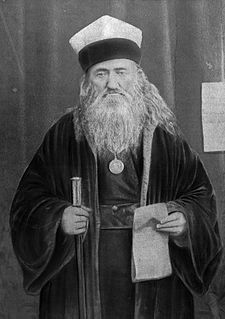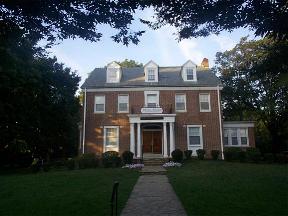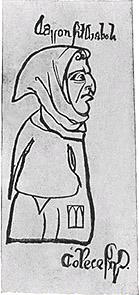
Sabbatai Zevi, also spelled Shabbetai Ẓevi, Shabbeṯāy Ṣeḇī, Shabsai Tzvi, and Sabetay Sevi in Turkish, was a Jewish mystic and ordained rabbi from Smyrna. A kabbalist of Romaniote or Sephardic origin, Zevi, who was active throughout the Ottoman Empire, claimed to be the long-awaited Jewish Messiah. He was the founder of the Sabbatean movement, whose followers subsequently were to be known as Dönmeh "converts" or crypto-Jews.
Yellow badges, also referred to as Jewish badges, are badges that Jews were ordered to wear at various times during the Middle Ages by some caliphates, at various times during the Medieval and early modern period by some European powers, and from 1939–1945 by the Axis powers. The badges served to mark the wearer as a religious or ethnic outsider, and often served as a badge of shame.

The history of the Jews in England goes back to the reign of William the Conqueror. Although it is likely that there had been some Jewish presence in the Roman period, there is no definitive evidence, and no reason to suppose that there was any community during Anglo-Saxon times. The first written record of Jewish settlement in England dates from 1070. The Jewish settlement continued until King Edward I's Edict of Expulsion in 1290. After the expulsion, there was no overt Jewish community until the rule of Oliver Cromwell. While Cromwell never officially readmitted Jews to the Commonwealth of England, a small colony of Sephardic Jews living in London was identified in 1656 and allowed to remain.
In the early modern period, a court Jew, or court factor, was a Jewish banker who handled the finances of, or lent money to, European, mainly German, royalty and nobility. In return for their services, court Jews gained social privileges, including in some cases being granted noble status.
The Jewish Naturalisation Act 1753 was an Act of Parliament of the Parliament of Great Britain, which received royal assent on 7 July 1753 but was repealed in 1754 due to widespread opposition to its provisions.
It is believed that the first Jews in England arrived during the Norman Conquest of the country by William the Conqueror in 1066. The first written record of Jewish settlement in England dates from 1070. They suffered massacres in 1189–90. In 1290, all Jews were expelled from England by the Edict of Expulsion.

Abraham (Avraham) ben Samuel Firkovich was a famous Karaite writer and archaeologist, collector of ancient manuscripts, and a Karaite Hakham. He was born in Lutsk, Volhynia, then lived in Lithuania, and finally settled in Çufut Qale, Crimea, where he also died. Gabriel Firkovich of Troki was his son-in-law.
The history of the Jews in Pennsylvania dates back to Colonial America.

Joseph Jacobs was an Australian folklorist, translator, literary critic, social scientist, historian and writer of English literature who became a notable collector and publisher of English folklore.
Aaron of Canterbury was an English rabbi and halakhic exegete, mentioned in Minhat Yehudah by Judah ben Eliezer on Deuteronomy xxvi.2, in association with Rashi and Rabbi Jacob of Orleans, and thus, seemingly, of the twelfth century. But a passage in the Close Roll of 1242 refers the decision in a divorce case to three "magistri," Mosse of London, Aaron of Canterbury, and Jacob of Oxford, and makes it probable that the Aaron mentioned in "Minhat Yehudah" was of the thirteenth century and acted as an ecclesiastical assessor, or dayyan, in London about 1242. If so, his name was Aaron fil Samson.
Elias of London also known as Elijah ben Moses or Elias le Evesque, was Presbyter Judaeorum in 13th-century England.
Aaron of York or Aaron fil Josce was a Jewish financier and chief rabbi of England. He was born in York before 1190 and died after 1253. He was probably the son of Josce of York, the leading figure in the York pogrom of 1190.

Samuel Joseph Fuenn, also known as Rashi Fuenn and Rashif (רשי״ף), was a Russian Hebrew writer, scholar, printer, and editor. He was a leading figure of the eastern European Haskalah, and an early member of Ḥovevei Zion.
Josce of York was the leader of the Jewish community in York, England, and the leading figure in the York pogrom of 1190. He committed suicide along with nearly the entire Jewish community, rather than face death or conversion at the hands of an angry mob.

Aaron Lopez (1731–1782), born Duarte Lopez, was a merchant, slave trader, and philanthropist in colonial Rhode Island. Through his varied commercial ventures, he became the wealthiest person in Newport, Rhode Island. In 1761 and 1762, Lopez unsuccessfully sued the Rhode Island colonial government for citizenship.
The Exchequer of the Jews was a division of the Court of Exchequer at Westminster, which recorded and regulated the taxes and the law-cases of the Jews in England and Wales. It operated from the late 1190s until the eventual expulsion of the Jews in 1290.
Antisemitism in the United Kingdom signifies hatred of and discrimination against Jews in Britain. Discrimination and hostility against the community since its establishment in 1070 resulted in a series of massacres on several occasions and their expulsion from the country in 1290. They were readmitted by Oliver Cromwell in 1655.

Few Jews arrived in Baltimore, Maryland, in its early years. As an immigrant port of entry and border town between North and South and as a manufacturing center in its own right, Baltimore has been well-positioned to reflect developments in American Jewish life. Yet, the Jewish community of Baltimore has maintained its own distinctive character as well.
Abraham ben Joseph of Orleans was an early 12th-century French Tosafist and the son of Joseph Bekhor Shor and the brother of Saadia Bekhor Shor. Some have suggested that he is identical with Abraham ben Rabbi Joce. Many of his interpretations of the Talmud are quoted several times in the Tosafot.







